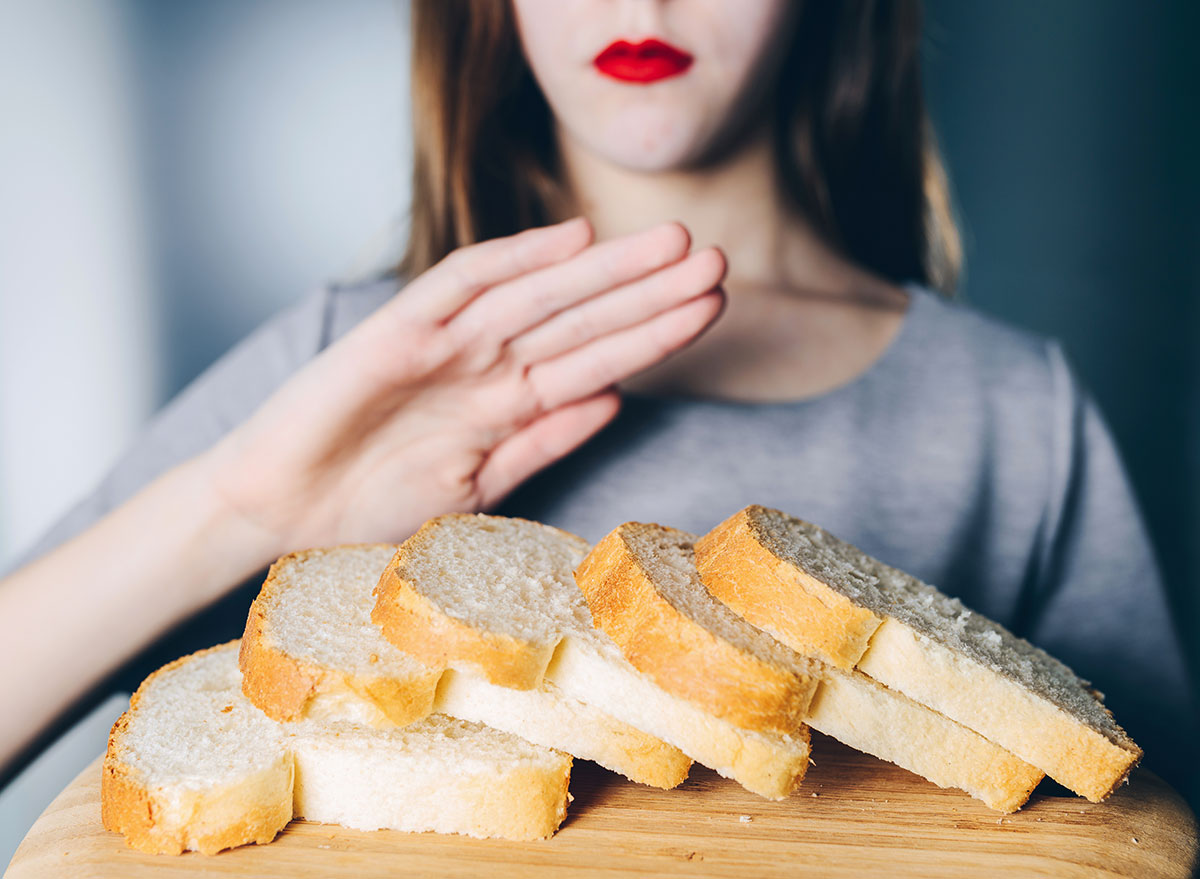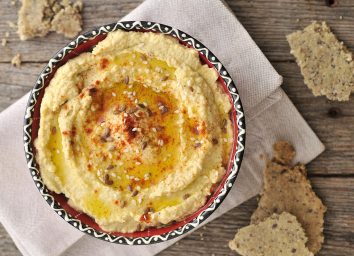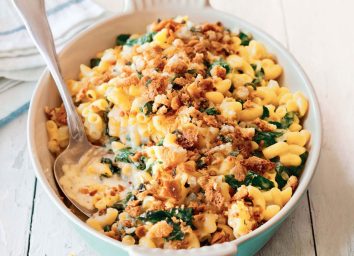Celiac Disease Diet: What You Can and Can't Eat With Celiac Disease

In case you haven't noticed, supermarket shelves and restaurant menus are filling up with more and more gluten-free items, from chickpea pasta to cauliflower pizza crust. And while a gluten-free diet has become undeniably trendy, for those with celiac disease, it's not a lifestyle choice—it's a necessity.
The cause of celiac disease is unknown, and it can develop at any age. It's estimated to affect 1 in 10 people across the world today, according to The Celiac Disease Foundation (CDF). The effects can range vastly. In fact, there are 200 known symptoms of celiac, which can occur in the digestive system or other parts of the body.
Coping with celiac disease requires a lifelong commitment to avoiding gluten in all forms. Unfortunately, this group of proteins is hiding in many popular foods, making it difficult to discern what's safe to eat. Wondering how to recognize gluten on a nutrition label? Not sure which grains you're supposed to stay away from? Looking for some celiac-friendly alternatives to some of your favorite foods? Whether you or a loved one in your household is adjusting to this diet following a celiac disease diagnosis, or you're simply curious about the difference between celiac and gluten intolerance, read on to find out the answers to all your burning questions about this common disorder.
What is celiac disease?
According to the CDF, celiac disease is an autoimmune disease that is detrimental to the lining of the small intestine when gluten—a protein found in wheat, barley, and rye—is ingested.
When someone with celiac disease consumes gluten, their body instantly triggers an immune response that attacks the small intestine, thus hindering nutrient absorption.
Amanda A. Kostro Miller, an RD and LDN who serves on the advisory board for Smart Healthy Living, notes that common symptoms of celiac disease include:
- abdominal pain
- diarrhea
- constipation
- bloating
However, the CDF reports that adults with celiac disease may or may not have digestive symptoms, and can experience other symptoms as well. These can include:
- fatigue
- bone or joint pain
- canker sores in the mouth
- migraines
- tingling
- numbness or pain in the hands and feet
- dermatitis herpetiformis (an itchy skin rash)
According to Miller, your doctor can test for celiac disease via an analysis of antibodies and/or a biopsy of the small intestine.
What's the difference between celiac disease and gluten intolerance?
Both celiac disease and gluten intolerance involve an adverse reaction to gluten. However, it's important to distinguish between the two. The former entails an autoimmune response to gluten, the latter is a condition that results from an inability to properly metabolize and absorb the protein.
It has long been assumed that people with gluten sensitivity do not experience the same intestinal damage as those with celiac disease. However, a 2016 study conducted by Columbia University Medical Center demonstrated that when individuals with gluten sensitivity (who never tested positive for celiac disease) were put on a diet that included wheat, some did experience a certain degree of gut cell damage.
"People's reactions to gluten can range from minor to severe," says Miller. "If you have a gluten intolerance, you may find that you can tolerate a certain amount of gluten and/or you can tolerate wheat/barley/rye as ingredients in certain foods. However, those with celiac should avoid all foods that contain gluten and/or ingredients that contain gluten."
For this reason, board-certified endocrinologist Dr. Anis Rehman recommends that anyone who has been newly diagnosed with either celiac disease or non-celiac gluten sensitivity seek out detailed medical counseling with a dietitian.
Unlike celiac disease, Miller says there is no test for gluten intolerance. That's why she advises seeing a registered dietitian if you suspect you have this condition—as they may recommend an elimination diet to confirm that gluten is the culprit of your symptoms.
Foods you can eat on a gluten-free diet
Despite needing to avoid gluten, there are many foods you can still enjoy if you've been diagnosed with celiac disease. In fact, some foods, like fresh and frozen produce, legumes, and dairy products are naturally gluten-free.
According to Andres Ayesta, RD, LD, and founder of Vive Nutrition, as well as Monica Auslander Moreno, RD, LD/N, and nutrition consultant for RSP Nutrition, here are some of the core foods that are safe to eat on a gluten-free diet:
- Fresh, frozen, canned or dried fruit (with no gluten-containing additives)
- Fresh, canned, or frozen vegetables (with no gluten-containing additives)
- Eggs
- Meat, poultry, and seafood (as long as they're not breaded or dipped in flour)
- Dairy products (except some flavored milks and yogurts)
- Beans and legumes
- Nuts and seeds
- Certain grains (quinoa, millet, rice, amaranth, and teff)
- Potatoes
- Oils and vinegars
You'll likely have no issue finding a plethora of gluten-free crackers, pasta, bread, cereal, and much more on the supermarket shelves. However, when it comes to any processed foods, you need to be extra diligent about checking labels to ensure the products are, in fact, free of gluten and have not been cross-contaminated.
Foods you can't eat on a gluten-free diet
If you have celiac disease, it's imperative to stay away from gluten-containing foods—not only to avoid potential discomfort, but also to prevent damage to your GI tract.
So, it probably goes without saying that a slice from a traditional pizza joint or an Italian sub is off the table. But you'll also need to skip any bread, pasta, baked goods, or other products made with wheat, barley, rye, or triticale. That means croutons, breadcrumbs, and even seitan are a no-go. While fresh fruits and vegetables are fine, Miller warns that frozen and canned versions sometimes contain sauces or flavorings that feature gluten.
Here are some other foods to avoid while on the celiac disease diet, according to Dr. Sashini Seeni, a general practitioner of medicine at DoctorOnCall:
- Products containing wheat, barley, rye, or triticale
- Processed meats (salami, sausage, hot dogs, etc.)
- Processed cheeses
- Flavored yogurts with gluten-containing preservatives or other additives
- Farina
- Semolina flour/couscous
- Farro
- Spelt flour
- Graham flour
There are many other sneaky foods with gluten to be aware of, like soy sauce (which contains fermented wheat), pickles (which contain malt vinegar), and pudding (which contains wheat-based thickeners). According to Ayesta, condiments and seasonings often contain gluten as well. Even some canned soups and bottled salad dressings have wheat thickeners to give them a creamy texture.
It's critical to keep in mind that some foods that don't contain gluten are still at risk for cross-contamination. Oats, for example, are naturally gluten-free—but some are processed in facilities that also process wheat, barley, and rye. That's why it's a good idea to check the label to ensure the product has been processed in a gluten-free facility.
"The list of potential ingredients with gluten is exhaustive," says Moreno. "Celiac sufferers need to speak with their doctors about their particular sensitivity and needs."
When you're eating out, it's important to clearly communicate with your server about your need to avoid gluten. Be sure to specify that this need is due to celiac disease, not gluten sensitivity or a dietary choice. While certain dishes may appear safe, there could be gluten-containing additives in the sauces or seasonings that you don't know about. For instance, some restaurants add pancake batter (which is chock-full of gluten) to omelets in order to make them more fluffy.
"In a restaurant, you may need to worry about gluten cross-contamination on cooking surfaces," adds Miller. "Most foodservice operations cannot guarantee that they are gluten-free. Some people with severe gluten sensitivities may develop symptoms if food touches a surface that had flour or other gluten products on it. While I do not recommend being fearful of our food system if you have celiac disease, it is important to remain vigilant and voice your nutrition needs to those who cook for you so that they are aware."
Fortunately, Ayesta notes that many kitchens now have gluten-free certifications, which indicate that they use practices to avoid gluten cross-contamination.
How to read food labels
Determining if a product contains gluten requires some practice. Although some products are specifically labeled "gluten-free," the U.S. Food and Drug Administration doesn't require manufacturers to disclose gluten on food labels (only gluten-containing ingredients, like wheat).
If the packaging includes a "gluten-free" label, then you know that as per FDA guidelines, it includes less than 20 ppm (parts per million) of gluten. Still, not every gluten-free product has this label, so you may need to do some further investigating to assess whether it's safe to eat or not. Miller recommends checking the allergen warning section, which is usually located near the ingredients list, for wheat. Keep in mind, though, that a "wheat-free" label does not necessarily mean that a food is gluten-free, because it still may still include rye and barley. This is why it's advisable to scan the ingredients list for all forms of wheat, rye, barley/malt, and their derivatives. Corn flakes and rice puffs are considered gluten-free cereals, but they often contain malt extract/flavoring.
Keep a lookout for hydrolyzed wheat protein, hydrolyzed wheat starch, wheat flour, bleached flour, bulgur, wheat germ oil or extract, and wheat or barley grass, all of which either contain gluten or may be cross-contaminated. Many of the thickeners added to soups, salad dressings, and sauces, have wheat in them, but guar gum, xanthan gum, and carob bean gum are all celiac-friendly alternatives.
"Understand which products are at the highest risk for cross-contact with gluten," says Miller. "Flours and grains, for example, have high levels of contact with gluten, so consumers should purchase flours and grains specifically labeled gluten-free."
Other ingredients that may potentially contain gluten include modified (food) starch, (hydrolyzed) vegetable protein, (hydrolyzed) plant protein, vegetable starch, dextrin, and maltodextrin. You should be cautious when you spot terms like "natural flavoring" or "artificial flavoring" in the ingredients as well, as these can sometimes be made from barley.
When in doubt, always check with the manufacturer to clarify whether or not a product that includes any of these ingredients contains gluten, or could be cross-contaminated.
Gluten-free substitutions of popular foods
Just because you have celiac disease doesn't mean you have to forfeit your beloved pastries or pizza. Fortunately for those with celiac disease, it's easier than ever to find safe substitutions for popular gluten-containing foods, including baking mixes, bread, crackers, cookies, and more.
Craving a hearty plate of pasta? Seek out gluten-free products that are made from quinoa, rice, chickpea, or corn flour rather than wheat flour. Rice noodles and mung bean noodles are naturally gluten-free as well.
Cakes, cookies, and cereal that utilize almond meal or coconut flour, in place of wheat, rye, or barley, are also acceptable. Other gluten-free flour options include potato flour, pea flour, soy flour, arrowroot flour, tapioca flour, hemp flour, rice flour, sorghum flour, and buckwheat flour.
When it's time for taco night, use corn tortillas or brown rice tortillas instead of flour ones.
While there are many gluten-free crackers on the market, rice cakes are also a phenomenal option when you're seeking a crunchy accompaniment to cheese, gluten-free hummus, or salsa.
Many pizzerias make gluten-free versions of their pies, but if they also use wheat flour in the same kitchen, it's a good idea to ask whether there's a possibility for cross-contamination. You can also make your own pizza at home with a cauliflower or spaghetti squash crust.
And when a lazy weekend calls for a comforting batch of pancakes, all you have to do is swap out the wheat flour or all-purpose flour with cornmeal. As an added bonus, cornmeal contains more satiating protein than traditional flour.
Clearly, the celiac disease diet requires some strict restrictions and special considerations, but luckily, an increasing number of restaurants and food manufacturers are making it a point to ensure that there are tasty alternatives for those who need to avoid gluten. The more you can educate yourself on gluten-containing ingredients, the more easily and effectively you'll be able to read nutrition labels to make smarter, safer shopping choices.








